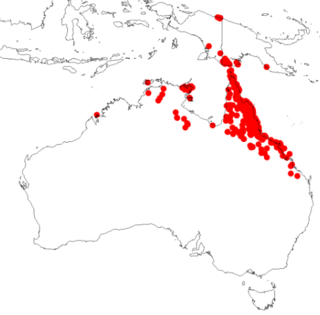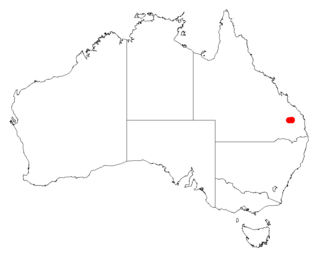
Acacia flexifolia, commonly known as bent-leaf wattle or small winter wattle, is a shrub species that is endemic to eastern Australia.

Acacia adoxa, commonly known as the grey-whorled wattle, is a species of flowering plant in the family Fabaceae and is endemic to north-western Australia. It is a dense, low-lying shrub with linear, more or less cylindrical phyllodes in whorls of 6 to 10, heads of golden-yellow flowers, and flat, sticky pods.

Acacia anomala, commonly known as Chittering grass wattle or grass wattle. is a species of flowering plant in the family Fabaceae and is endemic to a small area along the west coast of Western Australia. It is an erect, rush-like shrub mostly with a few linear to narrow elliptic phyllodes, spikes of golden-yellow flowers, and linear pods up to 50 mm (2.0 in) long.

Acacia angusta is a species of flowering plant in the family Fabaceae and is endemic to Queensland. It is a tree or shrub with thin, linear phyllodes, spherical heads of 12 to 20 flowers, and linear, thinly papery pods up to about 140 mm (5.5 in) long.

Acacia adenogonia is a species of flowering plant in the family Fabaceae and is endemic to northern Western Australia. It is a prickly, erect to sprawling shrub with cylindrical branchlets, egg-shaped to lance-shaped phyllodes, flowers arranged in spherical heads of golden yellow flowers, and thin leathery pods that are constricted between the seeds.

Acacia abbatiana is a species of flowering plant in the family Fabaceae and is endemic to Mount Abbott in Queensland. It has linear phyllodes, flowers arranged in a spike about 5 mm (0.20 in) in diameter, and a pod up to 35 mm (1.4 in) long.

Acacia simsii is a shrub belonging to the genus Acacia in the family Fabaceae. It is native to New Guinea and northern Australia. In Australia it is found in both the Northern Territory and Queensland.

Acacia acrionastes is a species of flowering plant in the family Fabaceae and is endemic to eastern Australia. It is a spindly, glabrous shrub or tree with linear phyllodes, flowers arranged in a racemes with 10 to 15 spherical heads of flowers, each with 12 to 16 creamy yellow flowers, and leathery pods up to 10 mm (0.39 in) long.

Acacia burbidgeae, commonly known as Burbidge's wattle, is a shrub or tree belonging to the genus Acacia and the subgenus Phyllodineae that is endemic to parts of New South Wales and Queensland.

Acacia neobrachycarpa is a shrub belonging to the genus Acacia and the subgenus Phyllodineae endemic to Queensland.

Acacia alleniana is a species of flowering plant in the family Fabaceae and is endemic to northern parts of Australia. It is a spindly, open shrub or tree with slender branchlets, thread-like phyllodes, and yellow flowers arranged in 2 to 6 spherical heads in the axils of phyllodes, and thinly leathery pods up to 150 mm (5.9 in) long.

Acacia eremophiloides is a shrub belonging to the genus Acacia and the subgenus Phyllodineae that is endemic to Queensland.

Acacia holotricha is a shrub belonging to the genus Acacia and the subgenus Phyllodineae that is native to parts of north eastern Australia.

Acacia aprepta, commonly known as Miles mulga, is a species of flowering plant in the family Fabaceae and is endemic to south-eastern Queensland. It is a spreading tree with furrowed bark, linear flat or slightly curved phyllodes, up to 3 spikes of yellow flowers, and linear, papery pods up to about 60 mm (2.4 in) long.

Acacia ammophila is a species of flowering plant in the family Fabaceae and is endemic to southern inland Queensland. It has linear phyllodes, flowers arranged in racemes or 2 to 4 spherical heads of 25 to 40 golden yellow flowers, and a pod up to 200 mm (7.9 in) long.
Acacia polyadenia is a shrub or small tree belonging to the genus Acacia and the subgenus Juliflorae that is native to north eastern Australia.
Acacia argyrotricha is a shrub of the genus Acacia and the subgenus Plurinerves that is endemic to north eastern Australia

Acacia elongata, also known as swamp wattle or slender wattle, is a shrub of the genus Acacia and the subgenus Plurinerves that is endemic to coastal areas of eastern Australia.

Acacia melvillei, commonly known as yarran, is a shrub of the genus Acacia and the subgenus Plurinerves that is endemic to south eastern Australia.
Acacia ammitia is a species of flowering plant in the family Fabaceae and is endemic to Ngarrabullgan in north-east Queensland. It is a spreading shrub or tree with lance-shaped phyllodes and flowers usually borne in two spikes in leaf axils.
















